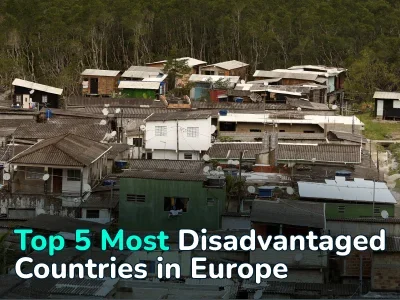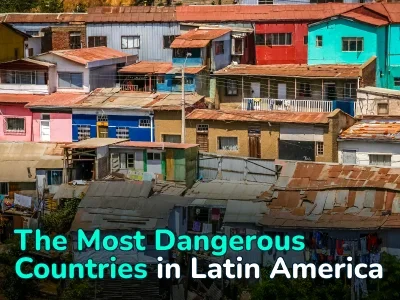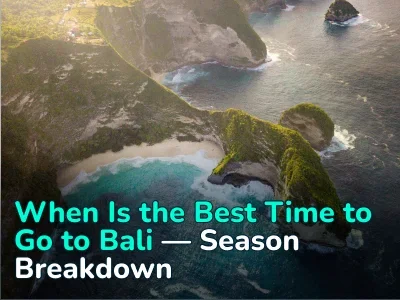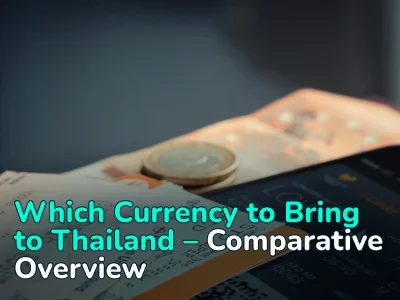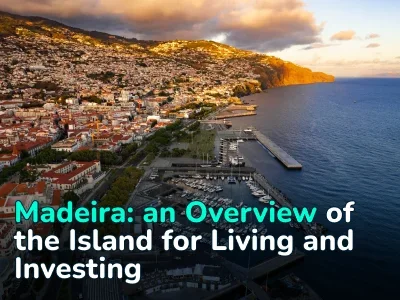
Where to Go in Winter if You are Fond of Warmth and Exoticism? 5 Great Destinations for Snowbirds
How about waking up to the sound of surf or jungle in winter? If you have the desire and ability to work remotely, then it’s time to go for the wintering and become a snowbird. While you are gathering your thoughts, we will tell you in detail about 5 exotic destinations where you can go for the wintering already this year.
The choice of countries for wintering is quite extensive. We have already written about the countries in the south of Europe for a budget wintering, and today will tell you where else you can extend the summer, but this time turn to more exotic destinations. By choosing one of our wintersun destinations, you will replace down jackets and winter boots with slates and shorts, immerse yourself in a different culture and lifestyle, and meet like-minded people.
We have selected five interesting wintersun destinations — Egypt, India (Goa), Vietnam, Panama, Mauritius — and are ready to tell you about each of them, laying out the most important points: whether you need a visa, what the weather is like in winter, when it is better to come to winter, pros and cons of wintering, tips, cost of living per month (rent, utilities, food, transportation).
Egypt
Egypt is a country with most of its territory in the Nile Valley of North Africa. However, since it also borders the Mediterranean Sea to the north, it is also called a Mediterranean country. For wintering, the oldest civilization in the world is ideal, as the climate at this time of year is quite comfortable (in contrast to the exhausting hot summer).
Popular Places for Wintering
The resorts and beaches of the Red Sea: for example, Sharm El Sheikh, Dahab, Hurghada or Marsa el-Alam.
Is a Visa Necessary?
A tourist visa on arrival costs about 25 USD and is valid for 30 days; an e-Visa is also available, including a multi-entry option for 60 USD, with on-site payment usually in cash in USD/EUR/GBP and a passport must be valid for at least 6 months. To stay longer, you will need to extend the visa at the migration office.
Weather in Winter
In winter the daytime temperature in Egypt remains moderate and averages around +20-22 ° C. The days are sunny and pleasant, and rain in southern Egypt is almost a mythical creature and happens very rarely. Nights are often cooler, with winds and temperatures dropping to +10 °C or lower.
When is the Best Time to Come for Wintering?
The comfortable season for wintering is from November to March. Of these, the warmest in terms of beach holidays are November, late February and March.
Pros and Cons of Wintering
As of pros:
- Lodging and food are cheaper than in South Asia.
- Azure waters and gorgeous beaches with soft white sand.
- Red Sea resorts are considered some of the best places in the world for diving, windsurfing and kitesurfing.
- The opportunity to enjoy the sights of Egypt in silence and without the crowds of tourists.
- Perfect time to cruise the Nile, and for some extreme adventures, whether it’s kayaking from Aswan to Luxor, clambering in Dahab, riding a motorcycle off-road in the desert, or hiking through the Sinai.
- Winter street food. During this time, sweet potatoes and corn on the cob are roasted on the local streets, along with hot drinks such as «sahlab» (a warm milk-based drink), «hummus el sham» (a spicy tomato-based drink with a dash of chickpeas), and Turkish coffee.
As of cons:
- Chilly evenings.
- The dry climate — you will need to take moisturizers and hair conditioners.
- Beaches are usually not free.
- Water for drinking and cooking you must buy, you can not drink from the tap.
Tips
Some important notes for you:
- Take out insurance, because you will not be treated for free in local clinics.
- Find out where you can change money near the hotel or apartment; are there ATMs and what they charge (sometimes fees are very high, up to 10%).
- Do not pay for small purchases with the main card: it is better to have some cash.
- Think about what things to take with you, and what to buy on the spot. T-shirts, shorts and light dresses are not necessary — you should have good shoes, a few warm sweaters for the evening and good quality sunglasses.
- Check the cost and speed of internet. If you are not satisfied with the speed offered, you will have to install new lines at your own expense.
- Take from home all the necessary gadgets for work. It is also worth to buy adapters for the deepening of the sockets, since Egyptian sockets are mostly euro-style.
- Find out in advance where you can buy your usual products: in Egypt it can be difficult to find whole milk, plain black bread, some cereals, etc.
- Make sure you are familiar with the cost of travel within this country so you can defend your rights if the cab drivers charge you too much.
Cost of Living (Per Month)
According to Numbeo, the average rent is 1-room. in the center of Cairo in 2025 — about 8,300–10,300 EGP (about $160–$200+ with strong exchange rate volatility), outside the center ~6,600 EGP; utilities for ~85 m2 — about 1,200 EGP and above; Internet ~620 EGP.
Products. A few examples: eggs (12 pcs.) — $1.44; water (1.5 liters) — $0.19; oranges (1 kg.) — $0.36.
Transport. Public transport (monthly subscription) — $5.91, a taxi ride will cost at least $0.39.
India, Goa
Goa is the smallest of the 29 states of India: from north to south it stretches for 105 kilometers, and from west to east at most 65 km. Today it is India’s main resort and a favorite place for wintering.
Popular Places for Wintering
North and South Goa are very different from each other, although officially there is no such territorial division in this state.
North Goa is a partying, free-spirited and creative part of the state. Features of this part of the state — the noisy beach parties, a lot of tourists and crowded markets. It’s also a much more affordable place to live.
South Goa will suit those who, on the contrary, looking for peace and comfort: there are fewer tourists and loud parties, and among tourists there are more people with money, families with children, and seniors. However, prices for everything are noticeably higher than in the north.
Is a Visa Necessary?
You can apply for an electronic visa (e-visa):
- 30-day e-Tourist Visa — maximum 30 days stay, double entry.
- Annual and five—year eTV - more entries, but 90-day continuous stay limits (for US/UK citizens/Canada/Japan — 180 days).
- You need to register at least 4 days before the trip.
Weather in Winter
Winter in Goa is comfortable and the heat in this period is not debilitating: during the day the temperature is about 32 °C, at night it is around 20 °C. The water warms up to 26 °C.
When is the Best Time to Come for Wintering?
The season in Goa lasts from November to April, but the heat starts in mid-March. It is worth bearing in mind that prices go up on New Year’s Eve. Good prices and comfortable weather hold from mid- to late December and after January 11.
Pros and Cons of Wintering
As of pros:
- Free beaches, beautiful views.
- The warm Indian Ocean, which is perfect for swimming and diving. Also among the activities are water skiing or water scooter riding; and for the extreme, surfing, jungle excursions and skydiving.
- Many attractions: beautiful temples and Portuguese forts, nature reserves, Dudhsagar waterfall, Old Goa, Panaji architecture.
- Variety. By renting a bike, you can visit a new beach every day in Goa, and each one will have its own twist.
- Yoga, spiritual practices, spas and Ayurvedic medicine are always at your service.
- You can star as an extra in an Indian film or TV series, and you’ll get paid for it.
- The local cuisine is famous for its spices and seasonings. Among the dishes worth trying are «biryani» pilaf, «paratha» flatbread, «burfi» dessert, etc.
As of cons:
- You need cash dollars to exchange them into rupees. You can exchange dollars for rupees at the best rate in exchange offices or jewelry shops.
- Evenings are cool and windy in December and January, so it’s a good idea to bring some spring and fall clothes.
- Wi-Fi is not everywhere, so many people buy local SIM cards to work.
- You must have health insurance, you can drink only bottled water.
- A bike is indispensable. You can rent a scooter or motorcycle in many rental shops.
Tips
- In Goa you will need the skill to haggle, especially in the local markets and private shops: it is the norm for the Hindus, and they can easily haggle with you for 15-20 minutes.
- It is a good idea to have a variety of medicines: Indian cuisine is undoubtedly delicious, but often very spicy and tangy. It is also advisable not to buy ready-made meals from street vendors.
- The language of communication is English, but it is better to use its most primitive form.
- If you stay on the north side, it is worth checking out the local parties — the fame of them goes far beyond India. By the way, Goa is considered the birthplace of «trance» in music.
Cost of Living (Per Month)
Housing. Rent a one-bedroom apartment in the city center is $200, not in the center is $120. You can also rent a bungalow, a room in a hostel and entire houses.
You can search for lodging on online services, but it’s recommended to do it on the spot. The best way is to pre-book a room in a hosthouse for a couple of days, and during this time to look at a place for a long term in person.
Utility bills. Basic services (electricity, heating, water, garbage) on average will cost $40, plus internet (about $8).
Groceries. Some examples: mineral water (0.5 liters) — $0.2, milk (1 liter) is $0.70, eggs — $0.97, inexpensive lunch for one — $3.
Transportation. Rent a bike — from $3 per day, cab ride — $0.88.
Vietnam
Vietnam is located in Southeast Asia, stretching a narrow strip of land from north to south of the Indochina Peninsula. More than 80% of the country is mountainous, and forests cover about 30%. The entire eastern part of the country is washed by the sea.
Popular Places for Wintering
It is common practice to consider resort towns for wintering, as megalopolises are noisy and dirty. The most popular regions for wintering are Nha Trang, Da Nang, Con Dao, Phu Quoc, Phan Thiet, and Mui Ne.
Is a Visa Necessary?
Many citizens of European countries (Germany, France, Italy, Spain, UK, Russia, Japan, Korea, Scandinavia) — 45 days without a visa.
Since August 2025, 12 European countries (Belgium, the Netherlands, Poland, the Czech Republic, etc.) have been added — 45 days.
Some Latin American countries — 90 days.
Weather in Winter
The weather depends on the region: if you take central Vietnam, from December to February the temperature stays at +22-25 ° C. The sea is warm during this time, but the waves are sometimes choppy and it rains occasionally.
When is the Best Time to Come for Wintering?
The most popular months for wintering in Vietnam are from December to April. At this time airfare is 2-3 times more expensive, so it is better to arrive before the season or between its peaks. About buying tickets should be taken care of in August and September.
Pros and Cons of Wintering
As of pros:
- South China Sea, rich with beautiful species and fauna. It is also a great place for snorkeling and diving.
- Many interesting cities, beautiful Buddhist temples, a pearl farm, centers of alternative medicine and spas.
- From Vietnam you can easily and quickly get to neighboring Laos, Cambodia and Thailand.
- A paradise for seafood fans.
As of cons:
- Hotels and services in winter are expensive compared to India or Egypt.
- It’s pretty dirty everywhere, especially outside the hotels.
- Strange combinations in food. Vietnamese are very fond of sweets, so they can add condensed milk to tomato juice, for example. There is also no culture of eating vegetables and salads.
Tips
- Take dollars with you: you can exchange them for Vietnamese dong at any bank, hotel, or street shop. In addition to cash, it is advisable to have several bank cards.
- It’s worth taking out an extended insurance policy, especially if you have a chronic illness.
- In Vietnam there is a nuance with the tables: they either do not exist at all, or they are made for people of very small height. So to work you can buy an inexpensive garden table under the height of 170 cm.
- Internet in houses everywhere is different and not always fast enough. If anything, SIM cards with 3G in Vietnam are sold on every corner.
- It is strictly forbidden to take pictures of military installations, so don’t take any chances.
- Do not drink tap water and cocktails on ice in cheap cafes, and be careful with the local alcohol.
Cost of Living (Per Month)
Housing. Renting a one-bedroom apartment in the city center is $360, not in the center — $230.
In Vietnam, there are two types of housing: either conditionally «Vietnamese» style (something like a semi-apartment with a bedroom, living room and a minimal kitchen), or a European gesthouse.
Availability of air conditioning affects the cost of rent — without it it will be cheaper. The Vietnamese themselves often manage without it — just ventilate the room during the day.
Utility bills. Basic services (electricity, heating, water, garbage) on average will cost $65, plus internet (about $10).
Groceries. Some examples: milk (1 liter) is $1.44, chicken fillet (1 kg) — $3.65, eggs $1.51, fresh shrimp cost from $8 per kilo, one oyster — just under a dollar.
Transportation. Renting a bike is $60-85 a month, public transportation (monthly subscription) is $7.85, a cab ride will cost at least $0.64.
Panama
Panama is a warm tropical country in Central America. There is a 77 km long canal that connects the Pacific Ocean with the Atlantic Ocean. Besides the canal, Panama is also known for its beautiful landscapes and rich culture. Spanish is the official language, but English is widely spoken by locals.
Popular Places for Wintering
If you enjoy big cities, Panama City is the place to go: fresh seafood, tropical cocktails, and views of the Gulf of Mexico; the best white sand beaches are concentrated in Playa Blanca, Panama’s south coast resort; also popular places like Playa Coronado, San Carlos, Boquete, Pedasi.
Is a Visa Necessary?
Most countries require a visa for up to 90 days. For citizens of the USA and Canada — up to 180 days.
Proof of funds (~$500) and a return ticket are required.
The specific time limit is determined by the officer at the border.
Weather in Winter
Panama has a year-round tropical climate in the lowlands and a temperate climate in the highlands. The weather divides the year into two seasons: rainy and dry. The dry season lasts from December to April. During this time, daytime temperatures reach +32 °C, and it’s comfortable to swim in both the Caribbean Sea and the ocean.
Pros and Cons of Wintering
As of pros:
- Panama is one of the safest countries in Latin America.
- It has a long coastline, many beaches.
- The country has a lot of interesting things to do: golf, water sports, casinos, beach resorts, sport fishing, scuba diving, watching fabulous birds, tours to the rainforest, rafting.
- Panama has a vibrant nightlife, so you will have the opportunity to enjoy the sultry music of Panama.
- The transportation system is very good. Cabs, buses or small planes are fairly easy to get to most places. The roads around Panama are also in excellent condition.
- Accessible quality health care system. Hospitals and clinics are conveniently located throughout the country. Most doctors are internationally trained and speak English.
As of cons:
- Finding short-term accommodation can be difficult, as the country is still rather poorly adapted to winter tourism.
- The high humidity combined with the heat can be quite difficult to tolerate.
- The area around Panama’s capital city has dirty beaches and the ocean.
- Rather expensive to live in compared to Asia.
- Difficult without Spanish, as the language is ubiquitous here.
Tips
- The best time to book flights to and from Central America is 80 days before your departure date.
- Keep in mind that the farther you go from Panama City or David, the less good shopping and other amenities are available.
- The cheapest way to explore Panama is by bus. The outlying areas of the country (San Blas, Pearl Islands, etc.), on the other hand, can be reached quickly by domestic flights.
Cost of Living (Per Month)
Rent. One-bedroom apartment in the center of town — $900, not in the center — $650.
Utility bills. Basic services (electricity, heating, water, garbage) will cost an average of $105, plus internet (about $48).
Groceries. Some examples: milk (1 liter) costs $1.78, chicken fillet (1 kg) — $7.28, eggs $2.59.
Transportation. Public transportation (monthly subscription) is $25, a cab ride costs at least $2.50.
Mauritius
Mauritius is a small (75 km long and 48 km wide) island in the western Indian Ocean, east of Madagascar. Mauritius gained independence in 1968, before it was a French and British colony. Today, the island is a curious mixture of local color and European traditions. The official languages are English and French, but all locals speak Creole (a dialect of French).
Popular Places for Wintering
Depending on preference: the north of the island is chosen by those who want to hide from the waves and wind, south — fans of surfing and kitesurfing.
Is a Visa Necessary?
Many citizens enter without a visa for 60 days with the possibility of extending up to 180 days per year for tourism. The regime depends on the specific nationality — be sure to check before traveling.
When is the Best Time to Come for Wintering?
Briefly about seasonality in Mauritius:
- November-April is a warmer and wetter period.
- January-March is the season of cyclones and increased clouds.
- The best months are May-June and September-November (drier and more comfortable).
Pros and Cons of Wintering
As of pros:
- Stunning nature, climate, and clean beaches with light sand.
- One of the safest countries to travel: no deadly poisonous insects on the island, the crime rate is low.
- There is something to see: a national park, waterfalls, the Botanical Garden in Pamplemousses, seven-color sands, lakes in the craters of extinct volcanoes, tea plantations, etc.
- Wi-Fi works well in tourist spots.
- Comfort and atmosphere of complete tranquility.
As of cons:
- One of the most expensive resorts.
- Long flight. With a connection in Dubai, the flight will take at least 14-16 hours.
- For an independent traveler it is harder, because the service is designed for tourists on tours.
- It’s better not to go with children: there are no playgrounds, the beaches are not equipped for recreation with children.
- Stores work until 5 pm, and on weekends, many are closed.
- The lack of the usual pedestrian infrastructure and public transport. Without a car to get anywhere is very difficult. Public transportation exists, but it is irregular and not everywhere.
Tips
- Exchange your money for local rupees, which is best done at the airport. It is better to change dollars or euros. You can pay with a card in any store, but cash is useful, at least on the beach and at the markets.
- Travel around the island by car — it’s the best option. You can rent a car at the airport or take a cab. Do not take a bus, because you can hardly get somewhere without changing planes, and besides, local buses don’t have air conditioning.
- Buy an umbrella. With it, the beach holiday will be more mobile, because the local sun does not spare anyone.
Cost of Living (Per Month)
Rent. One-bedroom apartment in the center — $415, not in the center — $310.
Utility bills. Basic services (electricity, heating, water, garbage) will cost an average of $55, plus internet (about $30).
Groceries. Some examples: milk (1 liter) costs $1.34, chicken fillet (1 kg) — $5.62, eggs $2.14.
Transportation. Public transportation (monthly subscription) is $28, a cab ride costs at least $3.22.
Frequently Asked Questions About Wintering in Exotic Countries
What is wintering?
What documents are needed for wintering in exotic countries?
How to choose a country for wintering?
Which countries are suitable for wintering?
When is the best time to go for wintering?
Author
I am responsible for editorial work. I write expert interviews and guides.









